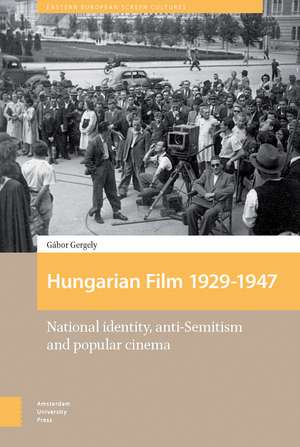Hungarian Film, 1929–1947 – National Identity, Anti–Semitism and Popular Cinema: Eastern European Screen Cultures
Autor Gábor Gergelyen Limba Engleză Hardback – 31 iul 2017
What does it mean for someone or something to be Hungarian? That was the far-reaching question that people grappled with in Hungary in the wake of the losses and transformation brought by World War I. Because the period also saw the rise of cinema, audiences, filmmakers, critics, and officials often looked at films with an eye to that question, too: Did the Hungary seen on screen represent the Hungary they knew from everyday life? And—crucially—did the major role played by Jewish Hungarians in the film industry make the sector and its creations somehow Jewish rather than Hungarian? Jews, it was soon decided, could not really be Hungarian, and acts of Parliament soon barred them from taking major roles in cinema production. This book tells the troubled story of that period in Hungarian cinematic history, taking it up through World War II.
Preț: 923.01 lei
Preț vechi: 1014.30 lei
-9% Nou
Puncte Express: 1385
Preț estimativ în valută:
176.61€ • 184.90$ • 146.14£
176.61€ • 184.90$ • 146.14£
Carte disponibilă
Livrare economică 15-29 martie
Livrare express 01-07 martie pentru 37.17 lei
Preluare comenzi: 021 569.72.76
Specificații
ISBN-13: 9789462980761
ISBN-10: 9462980764
Pagini: 330
Ilustrații: 30 halftones
Dimensiuni: 165 x 238 x 25 mm
Greutate: 0.64 kg
Editura: Amsterdam University Press
Seria Eastern European Screen Cultures
ISBN-10: 9462980764
Pagini: 330
Ilustrații: 30 halftones
Dimensiuni: 165 x 238 x 25 mm
Greutate: 0.64 kg
Editura: Amsterdam University Press
Seria Eastern European Screen Cultures
Notă biografică
Gábor Gergely is a Leverhulme Early Career Fellow at the University of Manchester.
Cuprins
Acknowledgements
A Note on Accents, Pronunciation, Names, and Spellings
Preface
Introduction
No Dividing Wall between Hungarian and Hungarian
Setting the Scene
Key Questions
The Nation as Auteur
What is Hungarian Film?
Structure
1 Key Concepts in Pre-1945 Hungarian Cinema
A Nation in Search of an Identity
Fragment of Empire: Borders
An Imagined Community: Nemzeti
Land of the Living Dead: Nemzethalál
Race and Racism
2 A Contested Film History
Contemporary Commentators
Communist Critics
Post-Communist Film Scholarship
Non-Academic Revisionism
Fruit of the Poison Tree
English-Language Scholarship
3 An Industry Emerges 1931-1935
Before the Sound: Silents
Then There Was Sound
István Székely and Hyppolit
What the Well-Dressed Jew is Wearing
Family Fortunes
Local Films for Local People!
Folksploitation
4 Boom, Crisis and Anti-Semitic Reorganization 1936-1941
Whose Film Is It Anyways?
Modern… But Not Too Modern
Stars
A Hungarian Invention
Trade Unionization Efforts
Two Faces of Gyula Kabos
The Nobility of the Hurt Little Man
The Worm in Our Bosom
A Downtrodden Majority
Arguments for the Implementation of Anti-Jewish Measures
A Need Well Met
Act 15 of 1938
The Film Chamber
Hungarian Resurrection
Act 4 of 1938
Putsching the Putschists
Hitler’s Motorways
Films about the Land: Inside/Outside
5 From War Boom to Bust 1941-1944
What They Can Do, We Can Do Better
New Stars
Bánky and Páger
The Hungarian Military Ideal: Representing War
Pinnacle of Hungarianness: Mountain Films
Seeing the Light
Fighting an Unseen Enemy: Doctors in Wartime Cinema
To the Glory of the Race
Arc Lights in the Blackout
Epilogue: Industry Reboot and the Myth of a New Start 1945-1947
Green Shoots
Out with the Bad Air, in with the Good
Justice and Ambition
Somewhere in Europe
Concluding Remarks
Bibliography
Index
A Note on Accents, Pronunciation, Names, and Spellings
Preface
Introduction
No Dividing Wall between Hungarian and Hungarian
Setting the Scene
Key Questions
The Nation as Auteur
What is Hungarian Film?
Structure
1 Key Concepts in Pre-1945 Hungarian Cinema
A Nation in Search of an Identity
Fragment of Empire: Borders
An Imagined Community: Nemzeti
Land of the Living Dead: Nemzethalál
Race and Racism
2 A Contested Film History
Contemporary Commentators
Communist Critics
Post-Communist Film Scholarship
Non-Academic Revisionism
Fruit of the Poison Tree
English-Language Scholarship
3 An Industry Emerges 1931-1935
Before the Sound: Silents
Then There Was Sound
István Székely and Hyppolit
What the Well-Dressed Jew is Wearing
Family Fortunes
Local Films for Local People!
Folksploitation
4 Boom, Crisis and Anti-Semitic Reorganization 1936-1941
Whose Film Is It Anyways?
Modern… But Not Too Modern
Stars
A Hungarian Invention
Trade Unionization Efforts
Two Faces of Gyula Kabos
The Nobility of the Hurt Little Man
The Worm in Our Bosom
A Downtrodden Majority
Arguments for the Implementation of Anti-Jewish Measures
A Need Well Met
Act 15 of 1938
The Film Chamber
Hungarian Resurrection
Act 4 of 1938
Putsching the Putschists
Hitler’s Motorways
Films about the Land: Inside/Outside
5 From War Boom to Bust 1941-1944
What They Can Do, We Can Do Better
New Stars
Bánky and Páger
The Hungarian Military Ideal: Representing War
Pinnacle of Hungarianness: Mountain Films
Seeing the Light
Fighting an Unseen Enemy: Doctors in Wartime Cinema
To the Glory of the Race
Arc Lights in the Blackout
Epilogue: Industry Reboot and the Myth of a New Start 1945-1947
Green Shoots
Out with the Bad Air, in with the Good
Justice and Ambition
Somewhere in Europe
Concluding Remarks
Bibliography
Index







